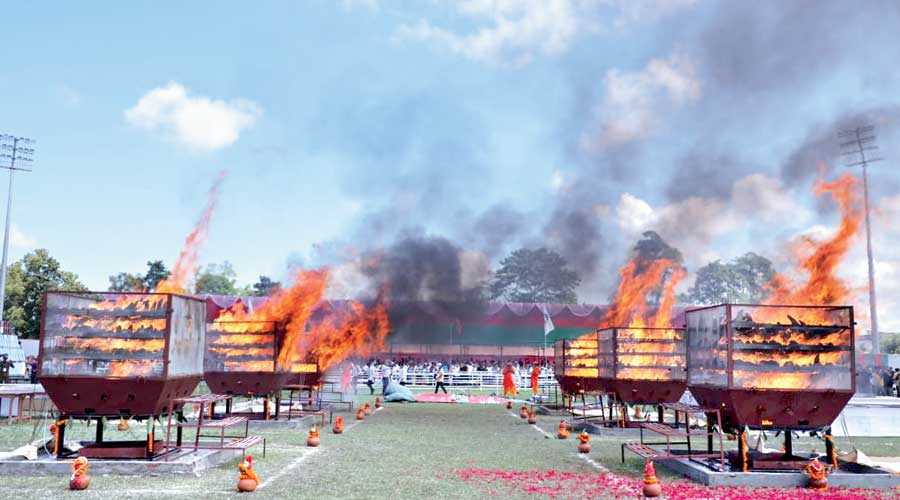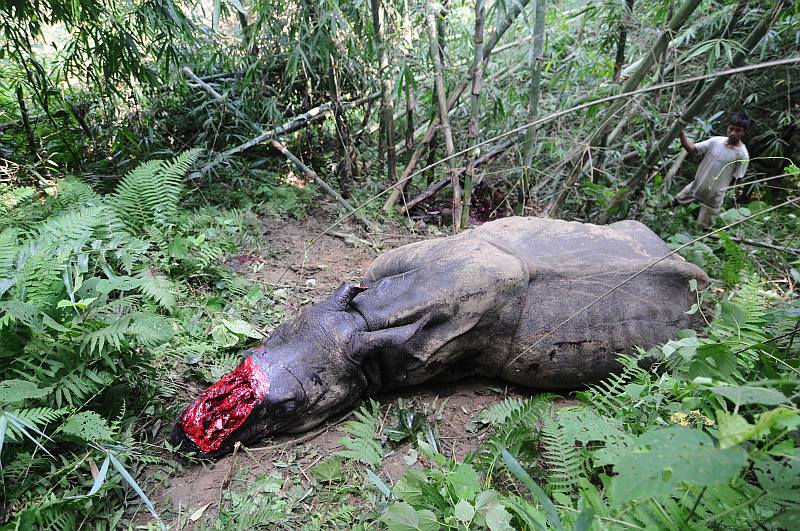In an event to mark World Rhino Day, the Assam government burned a stockpile of rhino horns to dispel the misconception that they have therapeutic value and send a strong message against rhino poaching and smuggling of its components. Himanta Biswa Sarma, the chief minister of Assam, stated that selling rhino horns would add value to the illegal poaching sector.
The pyres were lit remotely by drones by Assam chief minister Himanta Biswa Sarma, who was accompanied by several cabinet colleagues and experts from a variety of fields, including forensic science, veterinary science, biologists, government agencies, civil society, media personnel, policy makers, and bureaucrats. Sarma said that through this event, they hope to communicate to the rest of the globe that rhino horns have no medicinal value, and they wish to encourage people not to kill or buy the horns of these endangered animals based on superstitions or tales. “We should let rhinos live and flourish in their natural habitat,” Sarma remarked.

Just at event in Bokakhat in Upper Assam’s Golaghat district, a total of 2,479 rhino horns weighing 1,303.25 kg were sacrificed to the flames using six gas-based furnaces amid the singing of Vedic mantras and the blowing of sankhas (conch shells) by 21 priests. The horns took nearly six hours to destroy. Sarma said it was against the country’s law to sell or buy wildlife properties and resources, referring to accusations from a few quarters that the government’s collected stockpile of rhino horns may have been sold to create cash.

The population of larger one-horned rhinos, the state animal, has grown from 1,672 in 1999 to 2,652 according to the 2018 census, moving it from “endangered” to “vulnerable” on the IUCN Red List of Threatened Species. The greater one-horned rhino (also known as Indian rhino) population in Assam is the world’s greatest.
India cannot trade wildlife trophies because it is a signatory to CITES (Convention on International Trade in Endangered Species of Wild Fauna and Flora), and the greater one-horn rhino is listed in Appendix-1 of the CITES List. The Indian Wildlife (Protection) Act, 1972, as amended to date, prohibits the trade of rhino horn. The one-horned rhinoceros (Rhinoceros unicorns) is known as “Assam’s pride.”
Since the early 2000s, IFAW and WTI have been collaborating with the Assam government to reintroduce rhinos to Manas National Park, a UNESCO World Heritage site, after they were hunted to extinction during years of civil upheaval.Rhino numbers in the park have expanded because of this ground-breaking rescue, rehabilitation, and release project. Ganga, one of the first rhinos released in Manas, has just given birth to her fourth wild kid. She has at least one calf as a grandmother.
According to a statement by the forest department, poaching pressure on rhinos is persistent due to demand in some nations, and it is hoped that igniting rhino horns will debunk these unfounded misconceptions about their therapeutic use.Leading conservationists from around the world sent messages to the venue, applauding the decision to eliminate the horns.

The longest (57cm) and heaviest horns were among the 94 horns preserved (3.05kg). Drilling was used to retrieve samples for future genetic investigation from rhino horns that were indicated for destruction and preservation. Except for 15 African rhino horns, all the horns destroyed were from Asian rhinos. Few were taken from rhinos that had a natural death. Before being destroyed, the details of each horn were recorded and barcoded. Rhinos are frequently poached for their keratin horns, which are used in traditional Asian medicine.
An exhaustive process of reconciliation of rhino horns housed in seven treasuries of the state had been carried out by a commission chaired by the chief wildlife warden of Assam, with the support of a technical committee and seven relevant zonal committees, prior to selecting the horns for destruction. Amid civil society members, members of non-governmental organization, journalists, police, and district administration officials, the re-verification or reconciliation exercise was performed.
The entire procedure was carried out in accordance with Section 39(3)(c) of the Wildlife (Protection) Act, 1972, which included a public hearing on August 21. The move was met with no opposition. According to Talukdar, the component deals with the destruction of wildlife parts.
Written by- Niki Shah
Edited by- Aditi Agarwal




